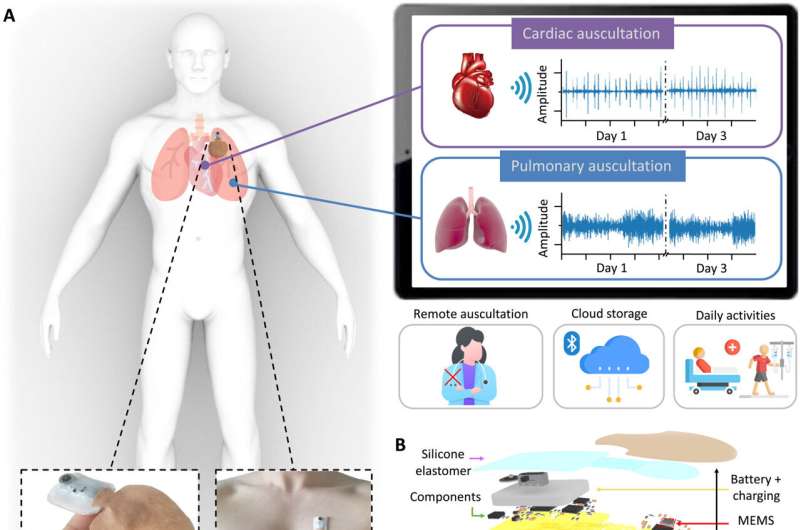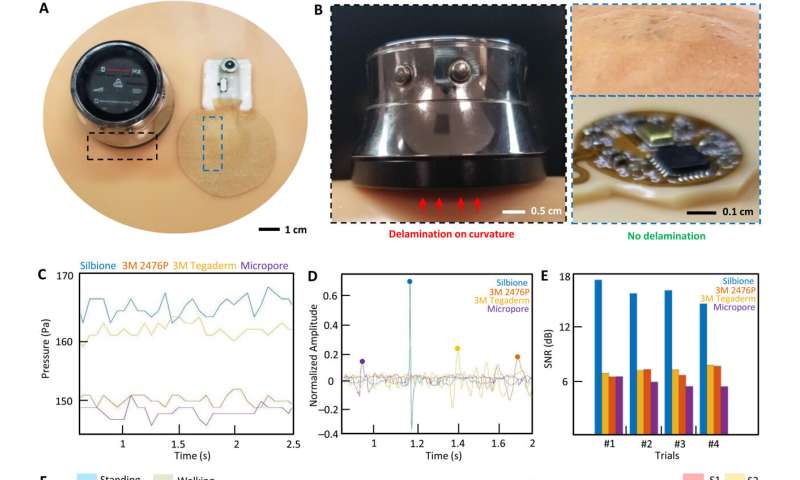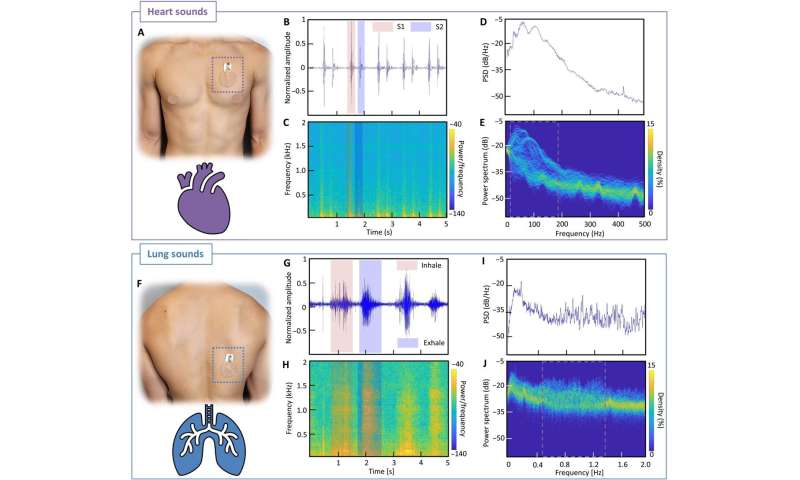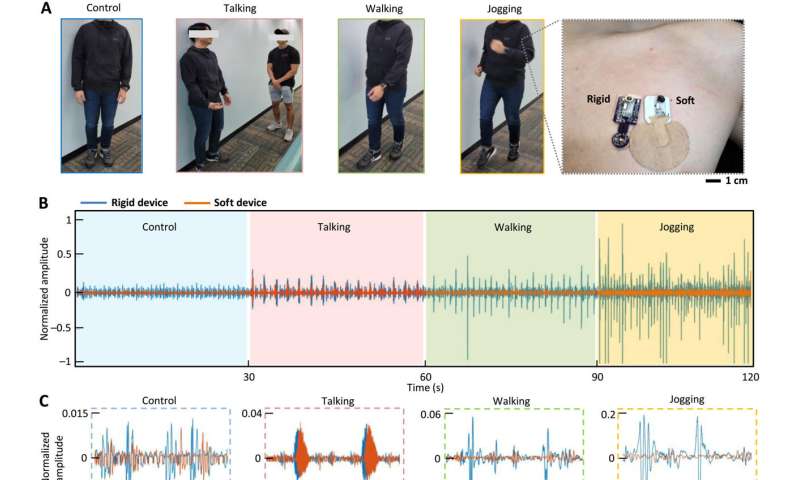Mark Zuckerberg says Meta wearables that read brain signals are coming soon
SOURCE: COINTELEGRAPH.COM
APR 19, 2024
A soft wearable stethoscope designed for automated remote disease diagnosis
SOURCE: MEDICALXPRESS.COM
JUN 03, 2022

Digital stethoscopes provide better results compared to conventional methods to record and visualize modern auscultation. Current stethoscopes are bulky, non-conformal, and not suited for remote use, while motion artifacts can lead to inaccurate diagnosis. In a new report now published in Science Advances, Sung Hoon Lee and a research team in engineering, nanotechnology, and medicine at the Georgia Institute of Technology, U.S., and the Chungnam National University Hospital in the Republic of Korea described a class of methods to offer real-time, wireless, continuous auscultation. The devices are part of a soft wearable system for quantitative disease diagnosis across various pathologies. Using the soft device, Lee et al detected continuous cardiopulmonary sounds with minimal noise to characterize signal abnormalities in real-time. The team conducted a clinical study with multiple patients and control subjects to understand the unique advantage of the wearable auscultation method, with integrated machine learning, to automate diagnoses of four types of disease in the lung, ranging from a crackle, to a wheeze, stridor and rhonchi, with 95% accuracy. The soft system is applicable for a sleep study to detect disordered breathing and to detect sleep apnea.
Auscultation in the field of medicine
Chronic obstructive pulmonary disease (COPD) and cardiovascular disease (CVD) are predominant factors of mortality worldwide. The two pathologies form an umbrella term for diseases of the heart and lung, leading to the malfunction and restricted blood flow during breathing. While approximately 80% of COPD mortality occurs in low-to-middle income countries due to healthcare inaccessibility, accurate auscultation can be helpful diagnose disease at an early stage and evaluate the treatment response. Similarly, heart sounds also facilitate diagnosis and the identification of vascular heart diseases.
Auscultation is the most basic and vital diagnostic method in medicine, due to its noninvasive, fast, informative and inexpensive use. Since most stethoscopes cannot record the detected sounds, the process can be limited via conventional stethoscopes, making it difficult to share the outcomes to record abnormalities. As a result, some of the critical respiratory and heart diseases can be misdiagnosed or underdiagnosed. Digital stethoscopes that assist auscultation in real-time can covert acoustic sounds to electrical signals to amplify inaudible sounds via acoustic stethoscopes. In this work, Lee et al introduced a soft wearable stethoscope system for ambulatory cardiomyopathy auscultation via a class of methods based on advanced electronics, flexible mechanics, and soft packaging for cardiovascular disease, and respiratory monitoring.

Mechanics, optimization, and control of motion artifacts with an SWS. (A) Photo comparing an SWS with a commercial device (TLO digital stethoscope) on the skin model. (B) Comparison of skin contact quality between the commercial rigid stethoscope (left) showing delamination from the skin due to the 45° curvature and the SWS showing intimate contact. (C) Difference of pressure applied on the microphone island using various biocompatible adhesives, including silbione, 3M 2476P, 3M Tegaderm, and micropore. (D) Time-series graph versus normalized amplitude for the S1 peak from the heart sounds using different adhesives. (E) Calculated SNR from S1 peaks from (D); there are four trials. (F) Time-series graph of the SWS versus the commercial device (TLO) when both are mounted on the chest; this subject conducts different activities, including standing and walking while recording the sounds. (G) Zoomed-in graphs for part of the noise peaks caused by walking; the SWS with skin-conformable contact (top graph) clearly shows S1 and S2 peaks, while the commercial one (bottom graph) shows step-noise amplified compared to the heart sounds. Credit: Science Advances (2022). DOI: 10.1126/sciadv.abo5867
Device design of a soft wearable stethoscope (SWS)
The team collected the cardiorespiratory data accurately during daily activities to diagnose pulmonary abnormalities. They then improved the signal-to-noise ratio from the wavelet-denoised sound collection, to minimize circuitry and made the device more compact to train a machine learning model to accurately identify stridor, rhonchi, wheezing, and crackling lung sounds. Lee et al also developed a user-friendly mobile device application to record heart and lung sounds, and uploaded the information remotely and securely. They formed the miniaturized, soft wearable system for remote patient cardio-pulmonary auscultation with exceptionally small and mechanically flexible devices, for flexible skin integration, and self-assisted auscultation to facilitate remote continuous monitoring without patient-physician physical interactions. The elastomeric enclosure maintained an inner silicone gel to assist skin contact, and included a thin, conductive hydrogel-coupled layer to auscultate cardiac and respiratory activities. The setup included multiple layers of soft materials and electronic components, including a microphone sensor, rechargeable battery, and thin-film circuits with a blue-tooth low-energy unit for wireless data transmission. The system maintained a microelectronic mechanical system microphone for sound recording, allowing the team to convert the sound collected from the microphone to digital signals via an analog-to-digital converter streamlined via the wireless chip for data processing. The fully portable stethoscope offered a unique opportunity to remotely monitor the digital health.
Conventional stethoscope vs. the digital stethoscope

Device performance in the monitoring of heart and lung sounds. (A) Photo of the SWS mounted on the chest (Botkin-Erb point) for heart sound detection. (B) Time-series plot of the 5-s window heart sounds, measured from a healthy subject. (C) Spectrogram of the time-series plot showing the frequency range of the measured signals. (D) Welch-plotted power spectrum density (PSD) over the heart frequency range from 0 to 500 Hz. (E) Persistence spectrum of the heart sounds showing the percentage of time that heart frequency is present in the signals around 20 to 180 Hz. Compared with the spectrogram, brighter colors represent unwanted noises in the surrounding. (F) Photo of the SWS mounted on the back (right lower lobe point) for lung sound detection. (G) Time-series plot of the 5-s window lung sounds from a healthy subject with normal breathing. (H) Spectrogram of the time-series plot showing the frequency range of the lung signals. (I) Welch-plotted PSD over the lung frequency range from 0 to 2 kHz. (J) Persistence spectrum of the lung sounds showing the percentage of time that lung frequency is present in the signals around 450 to 1350 Hz. Credit: Science Advances (2022). DOI: 10.1126/sciadv.abo5867
The team sought to maintain appropriate contact of the wearable microphone system to the skin. When compared to the commercial stethoscope, the thin and flexible digital stethoscope formed conformable contact for high-quality sound recording. Lee et al conducted experiments to compare the sound recording performance between conventional vs. digital stethoscopes, in which healthy subjects walked or stood with the device mounted on the chest and recorded sounds every five minutes. The device further demonstrated water-proof capabilities and breathability, for long-term use.
Detecting cardiac sounds in daily life and introducing a denoising algorithm for automated disease diagnosis
Since daily activities have diverse sources of noise, and can negatively affect recording sounds with a conventional stethoscope, clinicians perform auscultations in patients in a resting state. Lee et al demonstrated the performance of a digital stethoscope to regulate motion artifacts relative to the skin-contact quality by exploring a range of scenarios in which subjects mimicked a variety of real-life situations to show the influence of the measured sound quality. While the soft device allowed efficient sound recording, conventional stethoscope-like devices caused low-quality recordings of the heart and lung sounds. The team used additional filtering of the first-level cut-off frequencies to remove unwanted high-frequency noise.

Fully portable, continuous monitoring of cardiac sounds in daily life. (A) Series of photos showing different daily activities, including standing-control, talking, walking, and jogging. To demonstrate the device’s performance, the SWS is compared with a rigid device (right photo). (B) Graph showing cardiac sounds measured by both devices during different activities (control, talking, walking, and jogging). The SWS shows motion-artifact controlled data with negligible noise, while the rigid device has corrupted data because of device delamination from motions. (C) Zoomed-in data of measured cardiac sounds; motions from walking and jogging cause noise issues for the rigid one, while the SWS shows negligible effects. (D) Photos comparing two devices (top: SWS and bottom: rigid one) mounted on a soft skin model where the SWS shows conformable contact while the rigid device shows delamination (left photos), and magnified view of device structures without the top encapsulation (right photos). (E) Detailed design of the SWS showing skin-conformal contact for minimizing changes in skin-to-diaphragm air gaps. Credit: Science Advances (2022). DOI: 10.1126/sciadv.abo5867
The researchers studied wavelet transformation of heart, lung sound signals and noise filtering to capture sounds of the body and the surrounding. They accomplished this with a threshold algorithm to suppress noise in digital signals. The work showed superior performance of the soft wearable system by detecting lung sounds and abnormalities from various diseases. The new stethoscope provided a crucial advantage for continuous real-time recording of high-quality sounds, and quantitative data via convolutional neural network (CNN)-based machine learning, for automated disease classification. The team converged the smartphone app with machine learning to classify disease phenotypes in real-time.
Outlook
In this way, Sung Hoon Lee and colleagues developed a flexible, soft material noise-reduction mechanism and associated algorithm to fully realize a portable, continuous, real-time auscultation method with a wearable stethoscope. The team showed cardiopulmonary monitoring across multiple humans engaged in various daily activities. The soft wearable system is biocompatible and skin friendly, with integrated deep learning, applicable for successful clinical studies and remote disease analyses, suited for next-generation personalized biometric security systems.
Explore further
New software delivers advanced sound quality in heart and lung monitoring for newborns
More information: Sung Hoon Lee et al, Fully portable continuous real-time auscultation with a soft wearable stethoscope designed for automated disease diagnosis, Science Advances (2022). DOI: 10.1126/sciadv.abo5867
Pranav Gupta et al, Precision wearable accelerometer contact microphones for longitudinal monitoring of mechano-acoustic cardiopulmonary signals, npj Digital Medicine (2020). DOI: 10.1038/s41746-020-0225-7
Journal information: Science Advances
LATEST NEWS
WHAT'S TRENDING


Data Science
5 Imaginative Data Science Projects That Can Make Your Portfolio Stand Out
OCT 05, 2022

SOURCE: COINTELEGRAPH.COM
APR 19, 2024
SOURCE: HTTPS://INTERESTINGENGINEERING.COM/
NOV 16, 2023
SOURCE: HTTPS://WWW.AZOSENSORS.COM/NEWS
AUG 28, 2023
SOURCE: WWW.WHATGADGET.NET
JUL 11, 2023
SOURCE: HTTPS://WWW.THEHINDU.COM/SCI-TECH/TECHNOLOGY/INDIAS-WEARABLE-MARKET-GREW-47-IN-2022-BOAT-MAINTAINS-LEAD-REPORT/ARTICLE66493121.ECE
JUN 30, 2023